… or should I say a clean memory card on my camera. It’s about time too. Already, we are almost half way through January and I still have photos to share and stories to tell from last year! I have kept these photos on my card deliberately to remind myself about them every time I uploaded new ones and… well you know how it goes. Perhaps you might want to pour yourself a cuppa…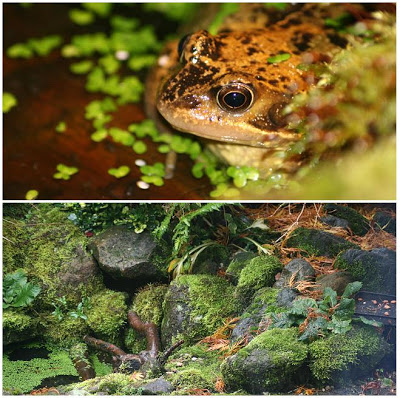 Ah… the frog living around my pond. This photo was taken one evening back in October and I don’t remember taking it now. I am guessing that was the last sighting of this frog. I wonder where it spends the cold winter months. Perhaps it is in one of the many caves I built in this area.
Ah… the frog living around my pond. This photo was taken one evening back in October and I don’t remember taking it now. I am guessing that was the last sighting of this frog. I wonder where it spends the cold winter months. Perhaps it is in one of the many caves I built in this area.
The mossy rocks around my pond are commented on many times but oops… I don’t remember why these photos were taken now either. Sometimes I just test light levels through the window – you can see some reflection on the RHS. However, this photo does show the success of the logs partial submerged in the water as a way to help wildlife in/out the water. The birds drink from them and the wren gets food around its edges. I love this mossy area.
Ah… yes the leaves! Yes… I am thinking now this was left as a photo reminder to mention regularly removing leaves from ponds during Autumn and Winter to stop the water turning oily on the surface. Ah… I see slight hints of it in my pond at the moment. I’ll need to get my net and a bucket out. If I catch it in time I shouldn’t need to change the water. I could take a bucket or two out and just top it up with rain water from my water butt.
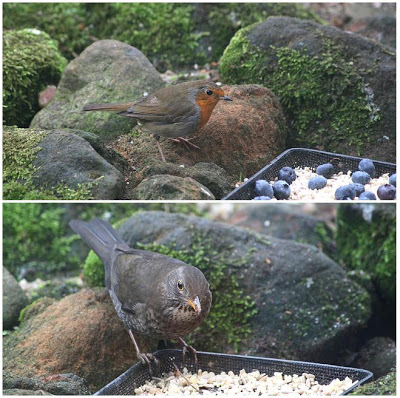 Not all moss stays on my sandstone rocks… the birds are responsible for some removal but not necessarily at nesting time as you can see in the photos above which were taken on December 27th. If you look closely you can see some sand on the beak of the female blackbird. Mm… the most recent culprit I suspect.
Not all moss stays on my sandstone rocks… the birds are responsible for some removal but not necessarily at nesting time as you can see in the photos above which were taken on December 27th. If you look closely you can see some sand on the beak of the female blackbird. Mm… the most recent culprit I suspect.
Now… I should point out that the blueberries that this robin is eyeing up aren’t the usual delicacy at this feeder! My teenage daughter had used the rest in a cheesecake topping and these ones were going soft. I didn’t see which birds ate them but they were all gone by the end of that day!
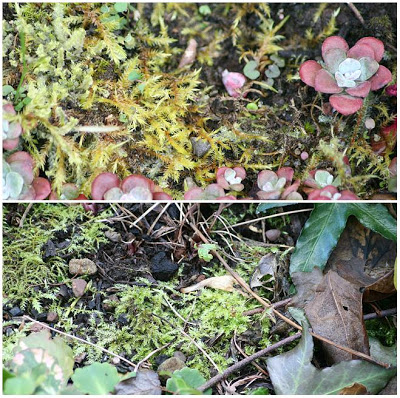 Back to the mosses… if you look more closely you can see subtle differences in form and colour. They look at one with nature, so woodland with their cushion mounds and elaborate weaving. However, that is not what these photo reminders were taken to show.
Back to the mosses… if you look more closely you can see subtle differences in form and colour. They look at one with nature, so woodland with their cushion mounds and elaborate weaving. However, that is not what these photo reminders were taken to show.
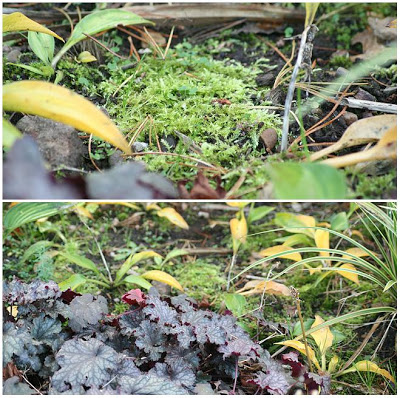 Mm… did you spot the purple leaves of the heuchera in the foreground? I don’t welcome the mosses in this area! Why don’t the birds lift these bits – I’m sure there must be insects below. Why don’t I welcome these mosses? Ah… I have a problem in my garden that some visitors may not know about. These photo reminders were taken back in the first week in October.
Mm… did you spot the purple leaves of the heuchera in the foreground? I don’t welcome the mosses in this area! Why don’t the birds lift these bits – I’m sure there must be insects below. Why don’t I welcome these mosses? Ah… I have a problem in my garden that some visitors may not know about. These photo reminders were taken back in the first week in October.
The problem? I don’t have many earthworms in my garden – in fact a sighting is cause for celebration! This moss is growing on the surface of the soil as the earthworms aren’t around to aerate the soil’s surface or the roots of plants. I need to do ‘worm’s work’ using my hand fork or hoe. I deliberately choose to use ground cover plants but there lies a problem with my hoe or hand fork because before the plants knit together the moss quickly fills in the spaces and I end up removing some plant material as I remove the moss. On the whole regular ‘worm’s work’ keeps the moss at bay but later on in the year when I’m not out in the garden as much, with rain or for other reasons, it can take hold as you can see above. It has been removed since.
You could argue that I am spoiling the natural wilderness that the moss provides, but this is growing in the middle of borders and on the top of the grit dressing on my rockeries. It can be seen in pots too. This moss needs to be removed. Not only will my plants suffer but insects and bees will suffer too if the plants don’t get a chance to grow well and produce flowers. I do have wild areas where I will let the moss grow but it very quickly covers shady and damp areas so I do have to keep it in check even there.
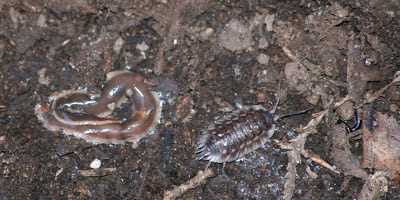 Do you recognise what is on the left of the photo above? I do hope many don’t! I’ve looked back files for this one. You are most likely to find it in damp places like under rocks or pots and I do I think that is exactly where I found this one back in 2007. I hadn’t seen one in while so assumed they had moved on. This chap is responsible for the absence of earthworms in my soil.
Do you recognise what is on the left of the photo above? I do hope many don’t! I’ve looked back files for this one. You are most likely to find it in damp places like under rocks or pots and I do I think that is exactly where I found this one back in 2007. I hadn’t seen one in while so assumed they had moved on. This chap is responsible for the absence of earthworms in my soil.
Let me introduce you to the New Zealand Flatworm and you don’t want this in your garden! It survives by absorbing the earthworm. It looks disgusting and this process is too. I’ll refer hardened readers to a previous posting where you can read more including how to reduce the spread of the flatworm. They must be caught and destroyed. It is as clear as that. However, I should say that a garden can survive with and after the flatworm – my garden is testimony to that.
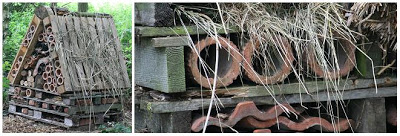 However there are many, many valuable insects and invertebrates in our soil that we can help survive the colder months of the year. Creating a winter habitat is a wonderful idea and can be a lot of fun too especially for young children who love mini beasts. What a great way to use up things lying about the garden, shed or garage. This certainly comes into the category of ‘Do one thing for nature’ and ‘cleaning up our environment’ both at the same time.
However there are many, many valuable insects and invertebrates in our soil that we can help survive the colder months of the year. Creating a winter habitat is a wonderful idea and can be a lot of fun too especially for young children who love mini beasts. What a great way to use up things lying about the garden, shed or garage. This certainly comes into the category of ‘Do one thing for nature’ and ‘cleaning up our environment’ both at the same time.
The Wildlife House above was seen back in July in a wood at Pensthopre Nature Reserve in Norfolk. Notice the holes drilled into the logs for insects to crawl into or even lay eggs. I wonder how many species were in there at the time and how many more are in there at this moment. Much simpler versions can be made. You could take a handful of canes, cut them into small lengths and tie them together with twine or string and hang it up or tuck it in a sheltered spot. You could also make holes in a a few logs and put them in a corner.
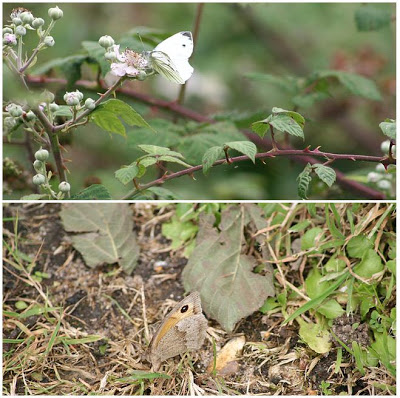 Most of us delight in seeing these guys above fly around in the summer months – except my daughter after a toddler experience in a butterfly house! By providing winter homes for wildlife we are increasing the chances of this in our own areas. Ladybirds and bees too will appreciate a winter residence. Is it too late to build one? Well, perhaps not… where I am the ground isn’t frozen over. In my garden I have a rule that it is better to do some work late than not at all. But that’s just me.
Most of us delight in seeing these guys above fly around in the summer months – except my daughter after a toddler experience in a butterfly house! By providing winter homes for wildlife we are increasing the chances of this in our own areas. Ladybirds and bees too will appreciate a winter residence. Is it too late to build one? Well, perhaps not… where I am the ground isn’t frozen over. In my garden I have a rule that it is better to do some work late than not at all. But that’s just me.
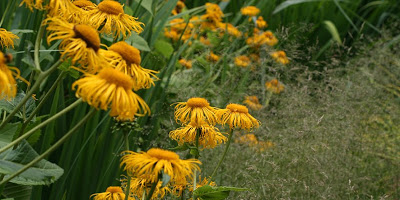 My trip to Pensthorpe last July gave so many wonderful photo opportunities, including the butterflies above. I have been holding on to this last image of our summer visit. Oh no… it wasn’t taken in Piet’s garden but instead on a woodland walk around one of the lakes. In fact it’s not that far away from the home for wildlife shown above. This was one of the last looks over my shoulder as we left this area.
My trip to Pensthorpe last July gave so many wonderful photo opportunities, including the butterflies above. I have been holding on to this last image of our summer visit. Oh no… it wasn’t taken in Piet’s garden but instead on a woodland walk around one of the lakes. In fact it’s not that far away from the home for wildlife shown above. This was one of the last looks over my shoulder as we left this area.
Unexpected drifts of plants winding through the trees. Soft grasses with tall golden daisy head flowers – some in the shade of the trees and others with stripes of sunshine across them. Just lovely! Yes… I do enjoy seeing birds and wildlife but plants will always be my first love – especially in woodland walks.
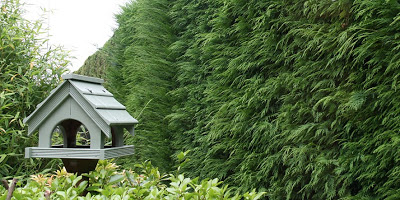 This was a photo reminder of how keeping a hedge regularly trimmed gives you more room inside the garden and pushes it right out into the background allowing our eyes to see the other plants instead. If you look closely you can see that we were trimming it at the time. The hedge then becomes a backdrop and a wind break – and hopefully not a nuisance to your neighbour too. We trim our Leylandii hedge in August.
This was a photo reminder of how keeping a hedge regularly trimmed gives you more room inside the garden and pushes it right out into the background allowing our eyes to see the other plants instead. If you look closely you can see that we were trimming it at the time. The hedge then becomes a backdrop and a wind break – and hopefully not a nuisance to your neighbour too. We trim our Leylandii hedge in August.
You can also see how close my bird table (and other feeders further along) is to my hedge. The birds are spending a lot of time in this hedge just now especially in the mornings. They pop out quickly to get food and back in again. The Sparrowhawk is still regularly popping by and over the weekend I saw it fly in and through this gap missing the bird table and the fairly large and wide bamboo planted to give the birds some protection.
In this tiny space the Sparrowhawk caught a bird sitting on a feeder less than a foot from the safety of the hedge. It was so quick. It dropped immediately to my lawn with the bird. I’m not certain but I am taking a guess, by the colouring of the head, that it was one of the Siskins that has been visiting recently. I stood up to see and it flew off with its catch.
When I first saw this happen in my garden I felt sick at the thought. However, I have to say I do find watching the flight of this bird, around the obstacles I have put in its way, quite fascinating! Yes, I know it has to eat to survive too just like the birds that come to my garden. I would just like to make a request that it moves on to other gardens now. I’d like to keep the Siskins a little while longer if you don’t mind. Numbers of Greenfinches are increasing now too. Yes… Mrs Sparrowhawk, please keep flying on by next time!
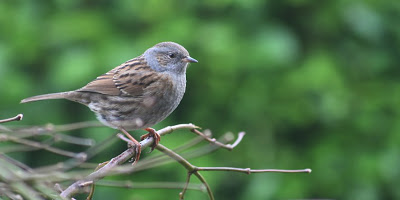 The Dunnock, being more a ground feeder bird, should be less likely to get caught by a Sparrowhawk. But… in my garden, even with food on the ground for them, they can be seen feeding from my bird table and fat feeders. It also uses the feeder hidden in my small domed Acer tree. Instead of jumping up from the ground it does the same as many other smaller birds. It lands on the top branches of the tree and bounces through them down to the food. So this was a photo reminder to say that although some birds are said to behave in certain ways from what I see in my garden they also adapt by watching others.
The Dunnock, being more a ground feeder bird, should be less likely to get caught by a Sparrowhawk. But… in my garden, even with food on the ground for them, they can be seen feeding from my bird table and fat feeders. It also uses the feeder hidden in my small domed Acer tree. Instead of jumping up from the ground it does the same as many other smaller birds. It lands on the top branches of the tree and bounces through them down to the food. So this was a photo reminder to say that although some birds are said to behave in certain ways from what I see in my garden they also adapt by watching others.
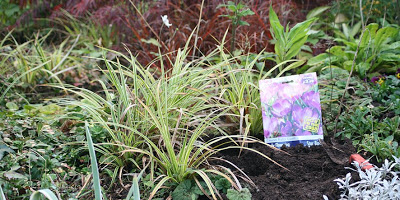 Bulb photo reminders are an excellent idea for me. This one wasn’t taken to post but as a reminder of what I put where. Perhaps others forget like me?
Bulb photo reminders are an excellent idea for me. This one wasn’t taken to post but as a reminder of what I put where. Perhaps others forget like me?
Back to the birds with a couple of ideas for more natural looking feeding areas in the garden. The montage below shows an area of twigs and logs below a bird table at a nature reserve. I liked this idea and partial adapted it in my own garden with a thought from the Pensthorpe wildlife home too. I’ll show this in another posting.
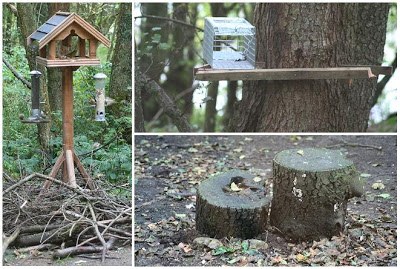 Tree trunks make the most natural bird and wildlife feeder of all but in a garden the roots of large trees are usually a problem so on the whole they are dug up and the trunk has to go. Although… I suppose you could cement a piece of tree trunk into the ground as you would do a post for fencing – that might work. I really meant to post this photo back in October when I took these photos – the ground is too hard for most people now. Perhaps an idea for next year?
Tree trunks make the most natural bird and wildlife feeder of all but in a garden the roots of large trees are usually a problem so on the whole they are dug up and the trunk has to go. Although… I suppose you could cement a piece of tree trunk into the ground as you would do a post for fencing – that might work. I really meant to post this photo back in October when I took these photos – the ground is too hard for most people now. Perhaps an idea for next year?
Have you any idea what the top right photo on the montage is about? I was certainly curious when I saw it at this Scottish Nature Reserve. I had never seen it on any other visit or since. This was a trap for a new visiting grey squirrel. The reserve was trying to catch it and planned to remove it completely from this estate which is home to the red squirrel. I don’t know if they ever caught it or not but I did see one running across the road in front of my car nearby on a subsequent visit. I do hope the red squirrel is not driven out here.
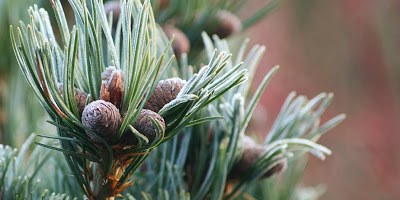 Frost and snow photos have been appearing in so many garden and bird blogs recently. What amazing photos too! Lucky us… we have only really had a couple of days of hard frost here (already posted on) but this image caught my eye since. Just a little frosting I grant you but I thought it pretty and I kept it as a photo reminder of how even the smallest of pine trees can have cones and what fun it is to watch the coal tits pull out the seeds from inside them. These cones have a bit of growing to do yet but I’m sure the coal tit will be up to the challenge of getting inside when the time is right. I couldn’t believe what it was doing the first time I ever saw this.
Frost and snow photos have been appearing in so many garden and bird blogs recently. What amazing photos too! Lucky us… we have only really had a couple of days of hard frost here (already posted on) but this image caught my eye since. Just a little frosting I grant you but I thought it pretty and I kept it as a photo reminder of how even the smallest of pine trees can have cones and what fun it is to watch the coal tits pull out the seeds from inside them. These cones have a bit of growing to do yet but I’m sure the coal tit will be up to the challenge of getting inside when the time is right. I couldn’t believe what it was doing the first time I ever saw this.
Growing teasel is something I have never done and I will be honest and say that I am in two minds about pulling it out. I grew it for the seed heads in winter as a food supply for goldfinches – sorry boys and girls if you don’t get interested in this soon it may go! I really grew so I could take photos/videos of the goldfinches eating from it. It is not really suited to this part of the garden but I positioned beside the feeders so the birds saw it and also so it would only seed into the bark below and not into my borders – I hope!
Ah.. but that was not why I kept it as a photo reminder. I did wonder why when I first looked at it last night. The teasel isn’t really in focus. The light sprinkling of snow isn’t that pretty either. Ah… but take a look closer! Sitting on a branch on the tree behind the teasel, almost looking like a seed head itself, is a Long-tailed tit.
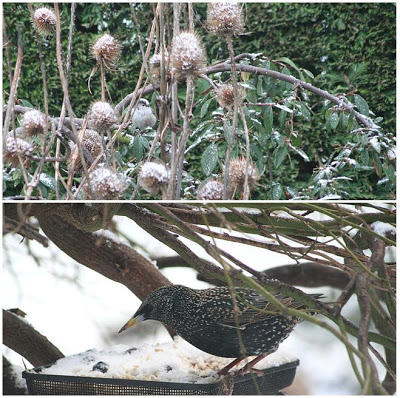 Ah… I remember now. This was a photo reminder to say that we’ve still had occasional visits of Long-tailed tit groups but we’ve also had one coming in on its own with the blue tits. This little chap seemed quite keen to explore without the group. It also shows how well camouflaged birds and wildlife can be and its so very easy to miss seeing things right in front of you. The Starlings, especially on a cold day, won’t be missed coming in their groups and with the squawking they do you can often hear them before you see them! They particularly love fat based foods.
Ah… I remember now. This was a photo reminder to say that we’ve still had occasional visits of Long-tailed tit groups but we’ve also had one coming in on its own with the blue tits. This little chap seemed quite keen to explore without the group. It also shows how well camouflaged birds and wildlife can be and its so very easy to miss seeing things right in front of you. The Starlings, especially on a cold day, won’t be missed coming in their groups and with the squawking they do you can often hear them before you see them! They particularly love fat based foods.
The camera card is empty now, outstanding stories told and photos shared. I’m ready for the new and current stories of 2009. Well… perhaps a video or two yet to come! Your tea/coffee must be cold now… oops.
My poll ‘questioning posting preferences’ is complete now and I’d like to thank everyone for voting. The ratios are pretty much as I expected with two/three postings per week – although not as long as this one!
I began blogging to post bird videos and I do still enjoy that immensely. I can’t wait to get using my outdoor wildlife cameras again too. However, I don’t believe I have succeeded in one other aspect. This year I plan promote plants more. If I was to be stranded on Dessert Island… it would be a plant I would take! Mm… that might be a good subject for a posting – I may come back to that one. Plants are my passion and I would like to share that passion more in 2009.
All photos above were taken from July 2008 to the present unless otherwise stated. They were taken both in and out the garden.
I stumbled on your blog by accident and have really enjoyed reading your posts. The pallet and tile leanto looks like a wonderful idea I could creat in my garden. You have some excellent ideas.
Marnie (Northern IL, USA)
I really enjoyed all your photos. I’m jealous you have a frog in your pond, I’m still waiting for one.
Hahaa, Lovely post Shirl.
I’m with you on the bulb problem, but that’s all part of the fun surely?? 😀
Lovely photos, and I’m glad you’re still getting LTT’s visiting!
A great run-through of what’s happening/happened in your garden and some really nice pics too.
I really enjoyed reading your post with a mug of coffee. I have a lot of moss in my garden and have always put it down to too much shade and a damp climate. I have never thought that the worm population could be a factor so will have to investigate sometime. I do leave it in some places but now have a major job on my hands to make sure that some plants do not get smothered. I liked your photo of the insect hotel and would love to do make something similar for my allotment. A desert island plant – now there’s food for thought – it might take me quite some time to decide 🙂
This comment has been removed by the author.
Hi Shirl, Whew, we did flit around a bit with that one, and so much fun too! I loved hearing you trying to figure out why you saved the shots, I do that too. I really like the idea for where the bulbs get planted too, with the tag even, such an excellent idea. I love all the bird and wildlife shots, and I do love the moss, but not that yucky flatworm, disgusting and bad! I hope you can get the earthworm population back up to speed so you don’t have to do so much worm work!
Frances
What a coincidence – I just posted about New Zealand flatworm on Sunday. I’ve never seen one in the flesh, as it were, and your real one looks much scarier than the ‘wanted’ poster at our allotment noticeboard. I take it you ‘destroy when found’?
In answer to your earlier question, yes, we’ve seen Moray Firth dolphins. I’m going to post about them soon on my Occasional Scotland blog.
That was fun taking a ride through time and what you were experiencing and learning along the way.
Thanks for sharing all your photos and details of time gone by… and whilst doing it thoroughly enjoyed a small cup of hot chocolate! Have you got any tips for encouraging the long-tailed tits to the bird table… we have them around but never feeding… Miranda
Hi there Marnie & gardenerprogress and hello again Liz, Moo, Anna, Frances, Linda, Bernie and Miranda 🙂
Marnie – Welcome, I’m so glad you did. Great, I’m thrilled that you’ve got some ideas. Yes, I liked the pallet lean-to too 😉 Gosh you’ve some snow fall in your garden. Ah… but I see you have lost of visiting birds too and a number of more unusual bird feeders – great stuff 😀
gardenerprogress – Great, there were quite a few I know. Ah… the frog… do you know that last year is the first I discovered this. I ran my own three week pondwatch and saw it then during my evening watching. Perhaps you could try looking late on in the evening. Some of my sightings were around midnight! Hope one comes to your garden too 😀 Oh… your daphne… now I am jealous!!! I had one many years ago and it died – perhaps too cold a winter. I should look into other varieties. As you said the scent is absolutely delicious 😀
Liz – Thank-you, its length did worry me a little but I am thrilled to use all the photos and tell the stories I had been holding on to. Great to come across another bulb… misplacer! Mm… fun well I don’t know as mine (in the past) never saw the light of day as I have planted on top of them many times!! Yes, but I do agree… if gardening was straight forward then it really wouldn’t be the same fun at all 😀 Yes, the LLT is such a treat to see 😀
Moo – Glad you enjoyed it 🙂 I’ve just be visiting you and I see you have a wonderful set up of bird feeders. What a great window view you must get too. Ah… the lovely Siskins, I do like to see them and they do stay a while at the feeders too don’t they? Thanks, you’ve got some nice pics too 😀
Anna – Great to hear… the coffee that is 😉 I don’t want to alarm you but it would do no harm to check under pots. The Flatworm is usually coiled up when you discover it but it can change its shape quite dramatically from incredibly thin to fat and squished up looking. You could set a trap made up of soil in a carrier bag placed on bare soil. You then check it in the morning and if there are any there you remove them (with a trowel) and put them in a jar of salted water. They must be destroyed. Within two days the water goes milky as their own poisonous enzyme gets them! Yes, I like the insect hotel too and an allotment would be a great place for one wouldn’t it? Yes, the desert island plant is post worthy – I picked mine as I wrote this post 😀
Frances – What a surprise it was to see your posting! Great minds and all that 😉 LOL, I was hoping someone else would do the same with the shots – I should have thought of you there! Yes, the bulb photos I started taking last year as I’m only now growing bulbs in my garden again after a long absence – the theory seems a good one 😉 Yes, moss is quite photogenic isn’t it and images of birds and wildlife always makes the garden so much more natural. Thanks, the flatworm really has done serious damage and I really don’t know when, if ever, my garden will get even an average number of earthworms. I daren’t bring in more. The more food the Flatworms gets the longer it will survive and the more it will reproduce!!! Some can grow really quite large too – disgusting!! I can cope with the ‘worm work’ to have the plants grow well 😀
Linda – Oh… I’m sorry I missed your posting – I had been checking for your next one too 🙂 Sadly, I’ve seen too many to remember in the flesh. Try not to be alarmed at not seeing earthworms at the moment. You are correct, your earthworms may well have gone further underground as the temps drop. Perhaps you could ask fellow allotmenteers. All I can suggest is that you set traps as I did – follow the link in my posting. I completely understand your concern. Oh yes… definitely destroy when found. You could keep a jar of salted water (with good fitting lid) down at your allotment. They can move quite fast and change their shape too so watch out for that if you see one. Most of the time you will find them coiled up. I can send you one of my photos for your allotment if you want – just email me. Ah… on a much more pleasant thought I’ll look forward to seeing your Moray Firth Dolphin photos. Were you on a boat or at the water’s edge? I’d need to be on the edge 😀
Bernie – Glad you enjoyed it 🙂 I do like to write posts in this way but perhaps not so long – I am my own worst enemy! Love your photos for today – especially the diving Goldeneye 😀
Miranda – Glad you enjoyed it and your hot choc too 😉 Ah… the long-tailed tits. They do seem a bit flighty when they come to feeders and their visits really don’t last that long if they come as a group. The single bird shown in this posting has explored more. Fat cakes/balls are what I’d say they like best followed by peanuts in a feeder that they can cling too – I have a hanging ball basket and a standard tube basket peanut feeder and they have gone to both. The single chap has also taken sunflower hearts from the low feeder in my small Acer tree – how it found that one I don’t know. It had a drink from the pond shortly after too! I guess if you want to encourage them to a bird table you could try hanging fat balls from it. Good luck 😀
I just love those moss photos. I would love to get moss growing on the rocks around my water feature. Did you do something to get it started? It is so thick and pretty.
I miss seeing the frogs and toads around. It won’t be long until we can see them again.
I really love these photos of your backyard birds. They are so beautiful and interesting. I especially love the English robin–so different from ours!
Wow. That was quite a photographic feast for sure, Shirl! I’d never seen or heard of that flatworm before, and hopefully I never see one here. Yuck! But all the other photos made up for that little unpleasantry.
Awesome post and love all the bird homes of different sizes and materials.
Wonderful post, really enjoyed the grand tour of your garden, you’ve got a lovely array of bird feeders there.
Paul.
Hi again Lisa, Susan, Jodi, Anna and Paul 🙂
Lisa – Great, so do I, the moss is especially suited to rocks isn’t it. No, I have done absolutely nothing for the moss to grow on mine. You’ll have seen Frances’s posting. She says with the heat of summer her mosses die back. Mine is there all year round and that is probably why it is so thick. This area doesn’t get full sun and really spends most of the time in shade. We don’t usually get baking temps here (at least for any length of time). This is one of the cooler spots in my garden and add that to the rainfall we can get and you have your answer. That is also why I can grow the blue meconopsis poppies there too. Yes, I’m looking forward to seeing the frogs and toads again too 😀
Susan – Thank-you, this year I plan to show more views of the garden and the feeding areas too. I’ll also keep the bird photos coming for you as well 😉 Yes, there’s the thing I find many of your birds interesting too. I love your cardinals and juncos as well as your finches which are really quite different from ours 😀
Jodi – Phew… I was so happy to finally get them off the camera card – it would have been easier to have filed them away earlier but I knew I wouldn’t come back to them that way. Glad you enjoyed them – the flatworm photo did its job well! I wanted it to be remembered 😉
Anna – Thank-you, I could have guessed you’d enjoy the variety of materials 😉
Paul – Thank-you, I plan more tours for 2009. I need to get another lens for my camera though – not happy with the original. Either that or a simple snap and shoot one. Birthday present ideas, I’ll have to drop more solid hints ;-D
What a mammoth post! However I can understand you needing to do it. I’ve got loads of film in my camera at the moment and no time to edit it (it is definately playing on my mind!). Really enjoyed reading about all the pictures. You lucky thing, you are now free to start from scratch again! Jane
I really loved reading this and going back in time a little and moving forward with each photo and story you shared, Shirl. I wanted to make a comment about each thing but by the time I got here, I've forgotten what I wanted to say!
I so love visiting your blog and will keep looking forward to your stories, photos, birds & plants…keep them coming;)
I, too, have SO many photos on my camera, or ones I have uploaded to my computer files, but then haven't posted. There are many untold tales and many unshared photos of a variety of happenings in the natural surroundings here; but time is a factor, and the effort it takes to upload them to blogger, and write. I liked how hoe just 'got it all out' and now feel fresh & ready to procede! I need to do something like that, and perhaps, I will:)
Jan
Thanks for the tip Shirl. I will certainly have a good look round under pots etc. I certainly hope that there are no flatworms about. I do think though that the moss has come about from excess rain and neglect in some places. Having recently finished work I should be able to get more done in the garden this year. I look forward to hearing about your desert island plant in a future post.
Hi Shirl,
Fantastic posting here. I loved your wintery plant photos.
Joe
I know what you mean about the Sparrowhawk. It would always be better if it ate someone else’s birds!
I’ve only had one in my garden but it missed the bird and sat on the fence for 5 minutes looking rather embarrassed 🙂
Hi again Jane, Jan, Anna, Joe and Denise 🙂
Jane – Yep… and I thought GBBD would have been much, much shorter… I do know what you mean about the video footage. I have tapes and tapes. If the footage is way long ago I don’t mind when I post it but it’s the more recent stuff (guessing the same with you) it niggles me 😉 Got one overdue posted tonight 😀
Jan – So glad you enjoyed it – I know what you mean about wanting to comment on everything as I’m like that myself. Thank-you, it is lovely to get such positive feedback 😀 Yes, I know what you mean about time and the untold stories. For a while I’d start posts and hold them in draft to come back to but things moved on in the garden and they went by the way. I wanted a clean slate for this year as I’m expecting it to be a busy one for activity in the garden. More bird species keep coming and with all my cameras for outdoors now I’ll have trouble with time myself. I don’t mind the uploading of photos at all – videos are much longer. The writing I love 😀
Anna – No probs. Yes, looking at forums etc it is being suggested that worms go further underground at this time of year so that could well be where they are. It’s best to be aware of what the flatworm looks like especially when you have al allotment as they will move about underground. I hope you are able to enjoy your garden more now. Ah… with you asking about the desert island plant I’ve just committed a posting to it – next Thursday if you want to join in 😀
Joe – Thank-you, yes the plants do look special at this time of year with their winter coats and colours 😀
Denise – Yes, but then again no. I’d like it to hunt in the countryside away from gardens. That would do 😉 Yes, I’ve seen that embarrassed look too! Oh… she went one step further today diving into a shrub! The tiny bird got away I think. I am assuming so as the Sparrowhawk returned later 🙁
That was a lovely review of your garden. I think my favorite is the frog picture!
I usually delete the garden and bird pictures from my memory card as soon as I put them on the computer. I also try to remember to make a backup copy of CD’s every few months. I’d be crushed to lose so many pictures.